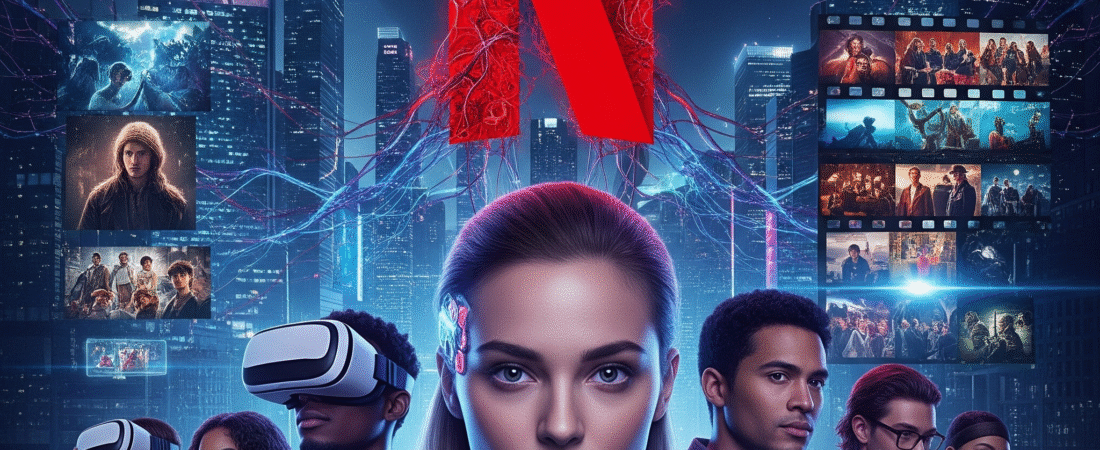Netflix is making waves across Hollywood with its bold integration of generative AI into the core of content production. This isn’t just about saving money—it’s about reshaping how entertainment is made and consumed. From improving visual effects to rewriting industry workflows, AI is quietly revolutionizing film and TV creation. The best example? The Eternaut, Netflix’s ambitious sci-fi series from Argentina, where AI helped deliver blockbuster-quality visuals on a much smaller budget.
But as Netflix pushes forward, the rest of the entertainment world finds itself split—some are inspired by the possibilities, while others are worried about what might be lost along the way.
—
Breaking Down Netflix’s AI Strategy
Faster, Cheaper, Smarter Production
Netflix isn’t just dabbling with AI—it’s fully embracing it. The company publicly acknowledged its use of AI tools like those from Eyeline Studios to speed up production and reduce costs.
In The Eternaut, a complex VFX scene showing a building collapse in Buenos Aires was completed ten times faster using AI. According to Netflix co-CEO Ted Sarandos, traditional VFX methods would’ve made such a sequence financially impossible for a mid-budget series. But with generative AI, Netflix made it happen.
This move isn’t just about making production faster. It allows global creators to bring big ideas to life, regardless of budget—democratizing access to high-quality visuals for storytellers worldwide.
—
Beyond Visuals: AI Throughout Netflix
Netflix is also applying AI to:
De-aging actors (like in Pedro Páramo, which cost a fraction compared to The Irishman)
Personalized search (users can now ask for content using natural language)
Advertising (interactive, AI-powered ads are expected later this year)
In short, Netflix is streamlining everything—from development to user experience—by embedding AI into the full content pipeline.
—
The Creative Debate: Empowerment or Risk?
Not everyone in Hollywood is on board. While some hail AI as a game-changing tool, others see it as a threat to human creativity and job security.
What the Optimists Say
Netflix positions AI as a creative assistant, not a replacement. Sarandos insists it helps “real people do real work with better tools.” Industry professionals like Davier Yoon of CraveFX agree, noting AI gives small studios access to blockbuster-level effects and speeds up localization, editing, and more.
What the Critics Fear
But others aren’t convinced. Concerns include:
Job loss for VFX artists, writers, voice actors, and other creatives
Ethical worries about AI being trained on copyrighted work without consent
Loss of human emotion in storytelling
Even filmmaker Tyler Perry paused an $800 million studio expansion over fears AI could upend job opportunities for thousands of workers.
—
The 2023 Hollywood Strikes: AI in the Crosshairs
AI played a major role in the 2023 Hollywood strikes. Unions like SAG-AFTRA and the Writers Guild of America demanded protections against AI replacing actors or writers. Behind-the-scenes teams, such as those represented by IATSE, are also pushing back.
In early 2024, over 13,000 creatives—including stars like Julianne Moore—signed a public letter warning AI companies not to use their likenesses or performances without permission. These labor battles highlight a key truth: current laws haven’t caught up to the speed of AI innovation.
—
Legal and Ethical Concerns: Trust, Consent, and Copyright
As AI becomes more widespread, audiences and industry insiders alike are questioning transparency.
Netflix admitted its use of AI in The Eternaut months after release, raising eyebrows.
Secret Invasion on Disney+ faced backlash for using AI-generated opening credits.
Viewers even suspected AI use in Netflix’s What Jennifer Did, though the company denied it.
These examples show how easily trust can be shaken. Many are now calling for mandatory labeling of AI-generated content, especially in non-fiction genres.
—
What AI Could Mean for the Future of Hollywood
More Stories, from More Creators
AI could help reduce costs by up to 30% in TV and film, according to Morgan Stanley Research. That means more creators can get their stories greenlit—especially from smaller studios or international markets. With AI, indie films can look like big-budget blockbusters.
AI as a Creative Tool, Not a Replacement
Netflix sees AI as a creative booster. It can help:
Simulate storylines or scenarios
Analyze scripts for flaws or structure
Support writers and directors with pre-visualizations
Maintain narrative consistency
Speed up editing and reduce expensive reshoots
Major studios like Warner Bros. are already using AI for script selection—helping them cut down on flops.
Still, AI isn’t a magic fix. It doesn’t replace human emotion or originality. Instead, it handles repetitive tasks and gives artists more time for true creative thinking.
—
The Road Ahead: Balancing Tech and Trust
The entertainment industry must now ask: how do we embrace AI responsibly?
What Needs to Happen:
1. Training for creatives
Teach artists and writers how to work with AI—so they can thrive, not be replaced.
2. Clear guidelines with unions
Protect workers’ rights, likenesses, and creative ownership.
3. Transparent labeling
Let audiences know when AI is used—especially in news or documentary content.
4. Ethical AI standards
Companies should use properly sourced data (aka “walled gardens”) to avoid copyright issues.
5. Public education
Keep audiences informed about what AI can—and can’t—do.

